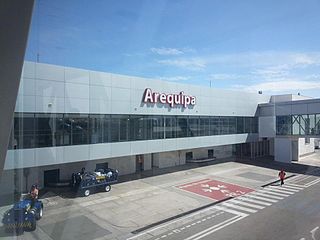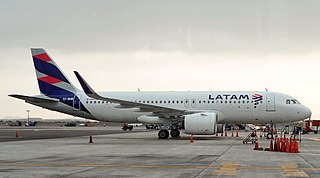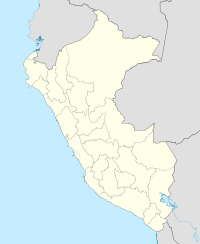
Cusco or Cuzco ) is a city in southeastern Peru near the Sacred Valley of the Andes mountain range and the Huatanay river. It is the capital of the Department of Cusco and of the Cusco Province. The city is the seventh most populous in Peru; in 2017, it had a population of 428,450. Its elevation is around 3,400 m (11,200 ft).

Machu Picchu is a 15th-century Inca citadel located in the Eastern Cordillera of southern Peru on a 2,430-meter (7,970 ft) mountain ridge. Often referred to as the "Lost City of the Incas", it is the most familiar icon of the Inca Empire. It is located in the Machupicchu District within Urubamba Province above the Sacred Valley, which is 80 kilometers (50 mi) northwest of Cusco. The Urubamba River flows past it, cutting through the Cordillera and creating a canyon with a tropical mountain climate. In reference to the site's name, for most English or Spanish speakers, the first 'c' in Picchu is silent. In English, the name is pronounced MAH-choo PEE-choo or MATCH-oo PEAK-choo, in Spanish as or, and in Quechua as.

Jorge Chávez International Airport is the main international airport serving Lima, the capital of Peru. It is located in Callao, 11 kilometers (6.8 mi) northwest of Lima Center, the nation's capital city and 17 kilometers (11 mi) from the district of Miraflores. In 2023, the airport served 22,876,785 passengers. Historically, the airport was the hub for Compañía de Aviación Faucett and Aeroperú. Now it serves as a hub for many aviation companies. The airport was named after Peruvian aviator Jorge Chávez (1887–1910). It is among the busiest airports in South America.
Aero Cóndor S.A., also known as Aero Cóndor Peru, was an airline based in Lima, the capital of Peru. It was founded and started operations in 1975, and provides domestic charter flights, cargo, scenic, and air ambulance services. Its main hub is Jorge Chávez International Airport in Lima.
Alejandro Velasco Astete was a Peruvian pilot, most recognizable for being the first man to fly over the Andes. He was 28 years old upon his death.

Cancún International Airport serves as the primary gateway for the Cancún Metropolitan Area in Quintana Roo, the Mexican Caribbean, Riviera Maya, and Yucatán Peninsula. Operating as a hub for Viva Aerobus and a focus city for Volaris and Magnicharters, it facilitates flights to over 100 cities across 30 countries in the Americas and Europe. The airport is managed by Grupo Aeroportuario del Sureste (ASUR) and is the easternmost airport in Mexico.
Inca Manco Cápac International Airport, known as Aeropuerto Internacional Inca Manco Cápac in Spanish, is an extremely high elevation airport serving in the city of Juliaca in Peru, 32 kilometres (20 mi) west of Titicaca Lake. Airport operations are run by Corporación Peruana de Aeropuertos y Aviación Comercial S.A. (CORPAC), a government entity that oversees management of Peruvian airports. Despite being classified as international, the airport does not feature any scheduled international nonstop flights. The airport has one of the longest runways in Latin America and the longest in Peru.

Rodríguez Ballón International Airport is an airport serving Arequipa, the capital of Arequipa Region and Peru's second largest city. This airport and Cusco's Alejandro Velasco Astete International Airport are the main air hubs in southern Peru. It is named for early Peruvian aviator Alfredo Rodríguez Ballón. It is the third most busiest airport in Peru.

Coronel (Crnl.) FAP Francisco Secada Vignetta International Airport is an airport serving Iquitos, capital of Loreto Region and Peru's fifth largest city. It is also known as Iquitos International Airport, and is one of the main airports in Peru.
FAP Captain David Abensur Rengifo International Airport is an airport serving the city of Pucallpa in the Ucayali Region of Peru. It is operated by Aeropuertos del Perú, S.A. Captain Rengifo Airport is the main airport serving the Ucayali Region.

LANSA Flight 502 was a Lockheed L-188A Electra operated by Líneas Aéreas Nacionales Sociedad Anónima (LANSA) which crashed shortly after takeoff from Quispiquilla Airport near Cusco, Peru, on August 9, 1970, after losing all power from one of its four engines. The turboprop airliner, registered OB-R-939, was bound from Cusco to Lima, carrying 8 crew and 92 passengers. All but one of the occupants died from injuries sustained from impact forces and post crash fire. Two people on the ground were also killed. There were 49 American high school exchange students on board, all of whom perished. A Peruvian government investigation concluded that the accident was caused by improper execution of engine-out procedures by the flight crew and lack of proper maintenance. LANSA was fined and its operations were suspended for 90 days. At the time, the crash was the deadliest ever in Peruvian history before being surpassed by Faucett Perú Flight 251 in 1996.
Air Perú International S.A.C. was a proposed Peruvian airline to be based in Lima, Peru. It planned to operate scheduled domestic and international services to Asia, Europe, South America and the United States. Its main base would have been Jorge Chávez International Airport.
Transportes Aéreos Cielos Andinos, normally referred to as Cielos Andinos, is an airline based in Lima, Peru. Its main base is Jorge Chávez International Airport in Lima. It began domestic operations on July 9, 2007, to Andahuaylas. Future destinations include Cajamarca, Ayacucho, Cusco, Puerto Maldonado, Chimbote and Arequipa.
Lineas Aéreas Nacionales S.A. was a Peruvian commercial airline headquartered in Lima, Peru, which was established in 1963. After its last Lockheed Electra crashed on Christmas Eve 1971, LANSA ceased operation, and lost its operating authority on January 4, 1972, when its working capital was exhausted.
Aviandina was a small airline from Peru, which was operational between 1999 and 2003.

The Amazing Race en Discovery Channel 1 is the first season of The Amazing Race en Discovery Channel, a Latin American reality competition show based on the American series The Amazing Race. Hosted by Harris Whitbeck, it featured eleven teams of two, each with a pre-existing relationship, in a race across Latin America to win US$250,000. The season was produced by RGB Entertainment. This season visited two continents and nine countries and traveled over 14,600 kilometres (9,100 mi). Starting in Iguaçu National Park, racers traveled through Brazil, Argentina, Chile, Peru, Colombia, Panama, the Dominican Republic, Costa Rica, and Mexico before finishing in Mexico City. The Amazing Race en Discovery Channel premiered on Discovery Latin America on Sunday 20 September 2009 at 10:00 p.m. (UTC-5). The season finale was aired on 13 December 2009 at 10:00 p.m. (UTC-5).
Expreso Aéreo was a small Peruvian regional airline based at Jorge Chávez International Airport. It was a passenger and cargo airline that operated from 1991 until 1997.

Chinchero International Airport is an under construction international airport in the town of Chinchero, which is located in the district of the same name, in Cusco Region, Perú. It is planned to replace Alejandro Velasco Astete International Airport. Its altitude is 3,720 metres (12,200 ft) above sea level.

LATAM Airlines Perú Flight 2213 was a scheduled domestic passenger flight in Peru from Lima to Juliaca. On 18 November 2022, the Airbus A320neo was taking off from Jorge Chávez International Airport when it collided with a fire engine that was crossing the runway, killing two firefighters and injuring a third, who died of his injuries seven months later. 40 passengers were injured. The aircraft was damaged beyond repair and written off, making it the first hull loss of the Airbus A320neo family.















